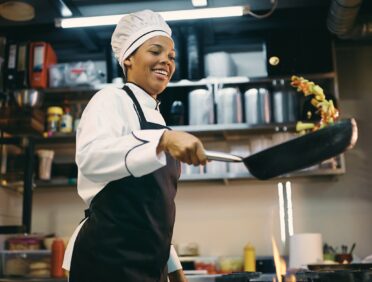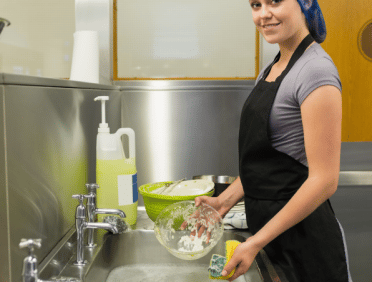What is food premises hygiene?
Food premises hygiene refers to the measures taken to ensure that the environment in which food is prepared, stored, or sold is clean and free from harmful contaminants. This includes maintaining a high level of cleanliness in food preparation areas, equipment, and utensils, as well as ensuring that food handlers follow proper hygiene practices such as washing their hands regularly and wearing appropriate protective clothing.
Proper food premises hygiene is essential to prevent the spread of foodborne illnesses, which can be caused by harmful bacteria, viruses, or other pathogens that can contaminate food. Food premises hygiene also helps to maintain the quality and freshness of food, which can affect its taste and nutritional value.
Some common measures taken to ensure food premises hygiene include regular cleaning and sanitising of surfaces and equipment, proper storage of food to prevent contamination, and regular training of food handlers on safe food handling practices. In the UK, food premises are also subject to regular inspections by health authorities to ensure that they are meeting hygiene and safety standards.
How does food hygiene and safety legislation protect businesses?
The UK has several food hygiene and safety laws in place to protect businesses and consumers from foodborne illnesses. These laws apply to all types of food businesses, including restaurants, cafes, food manufacturers, and retailers.
Here are some examples:
- Food safety management systems: food safety legislation requires all food businesses to have a documented food safety management system in place, based on the principles of Hazard Analysis and Critical Control Point (HACCP). By implementing a food safety management system, businesses can identify potential food safety hazards and implement controls to prevent them from occurring.
- Food labelling requirements: food labelling laws need businesses to provide clear and accurate information on food labels. This includes ingredients lists, allergen warnings, and nutritional information. By complying with these regulations, businesses can ensure that their customers are informed about what they are eating and avoid legal liability for any mislabeling.
- Food hygiene training: ensures that all food handlers are trained in food hygiene and safety practices. This training covers topics such as personal hygiene, cleaning and disinfection, and safe food storage and handling. By providing this training, businesses can reduce the risk of foodborne illness outbreaks and demonstrate their commitment to food safety.
- Food safety inspections: local authorities conduct regular inspections of food businesses to make sure that they are complying with food safety regulations. Businesses that fail to meet these standards may face enforcement action, including closure orders, fines, or legal action. By complying with these inspections and addressing any issues that are identified, businesses can reduce the risk of legal liability and maintain the trust of their customers.
Food hygiene requirements in restaurants
Food hygiene requirements in restaurants are designed to help customers receive safe and high-quality food. Some of the key food hygiene requirements for restaurants are:
- Personal hygiene: food handlers must maintain high levels of personal hygiene to prevent the spread of harmful bacteria. This includes regularly washing their hands with soap and water, wearing clean clothing, and tying back hair and wearing appropriate head coverings. Any food handler who is ill or experiencing symptoms of illness should not be allowed to handle food.
- Food storage: food products must be stored appropriately to prevent contamination and spoilage. Restaurants should be storing raw meat and poultry separately from other foods, keeping food at the correct temperature, and ensuring that food is covered and labelled properly.
- Food preparation: food must be prepared in a clean and hygienic environment. It means regularly cleaning and sanitising work surfaces, utensils, and equipment, and using separate cutting boards for different types of food. Raw food products must be cooked to the appropriate temperature to kill harmful bacteria.
- Food handling: food handlers need to avoid cross-contamination by using separate utensils and equipment for different types of food, such as meat and vegetables. It is a good idea for handlers to wear gloves when handling ready-to-eat food products.
- Cleaning and sanitation: Restaurants must maintain a clean and hygienic environment to prevent the spread of harmful bacteria. This includes regularly cleaning and sanitising all surfaces, equipment, and utensils, as well as regularly cleaning and disinfecting restrooms.
- Food safety management systems: Restaurants need to have a documented food safety management system in place, based on the principles of HACCP. This system should include procedures for identifying potential food safety hazards and implementing controls to prevent them from occurring.
Legal requirements for food businesses
Food businesses must adhere to the Food Safety (General Food Hygiene) Regulations 1995, which are a set of legal requirements that apply to all food businesses in the UK. These regulations are designed to ensure that food is safe to eat and to protect consumers from foodborne illnesses.
Some of the key requirements are:
- Registration: All food businesses must register with their local authority at least 28 days before starting their operations.
- Food hygiene training: All food handlers must receive appropriate food hygiene training.
- Food safety management: All food businesses must implement a food safety management system based on the principles of HACCP.
- Personal hygiene: All food handlers must maintain high levels of personal hygiene, including regularly washing their hands and wearing clean clothing.
- Premises hygiene: All food businesses must maintain a clean and hygienic environment, including regularly cleaning and sanitising all surfaces, equipment, and utensils.
- Food storage and handling: All food products must be stored and handled in a way that prevents contamination and spoilage.
- Traceability: All food businesses must be able to trace the source of their food products.
- Labelling: All food products must be labelled correctly, including allergen information.
- Inspection and enforcement: Local authorities are responsible for inspecting food businesses to ensure that they are complying with these regulations. Non-compliance can result in enforcement action, including closure orders and fines.
By complying with the requirements in the Food Safety (General Food Hygiene) Regulations 1995, food businesses can ensure that their operations are safe and legal, that the health of their customers is protected, and they avoid legal liability.
Hygiene standards for food businesses
Hygiene standards for food businesses in the UK are also guided by a range of legislation, including the Food Safety Act 1990, the Food Safety and Hygiene (England) Regulations 2013, and the Food Standards Agency’s Food Hygiene Rating Scheme. The key hygiene standards that food businesses must follow are very similar to those mentioned above and relate to:
- Personal hygiene
- Premises hygiene
- Food storage and handling
- Food preparation
- Food safety management
- Food hygiene training
- Traceability
- Labelling and
- Inspection and enforcement
Food safety – your responsibilities
If you own a restaurant, your overriding responsibility is to ensure that the food you produce and sell is safe for consumption. This includes taking steps to prevent contamination, ensuring that food is stored and handled correctly, and making sure everyone who works for the business comply with the relevant food safety regulations. Some of the specific responsibilities that food businesses have with respect to food safety include:
- Implementing a food safety management system: that is appropriate for your operations, which includes identifying potential food safety hazards and implementing controls to prevent them from occurring.
- Maintaining a clean and hygienic environment in which to prepare and store food. You should regularly clean and sanitise all surfaces, equipment, and utensils, as well as ensuring that your premises are free from pests.
- Ensuring personal hygiene: including making sure yourself and your colleagues regularly wash your hands and wear clean clothing.
- Providing appropriate food hygiene training: to all colleagues that come into contact with food.
- Ensuring food safety during storage and handling: to prevent contamination and spoilage.
- Providing accurate labelling: for all food products, including allergen information.
- Maintaining traceability: so that you can trace the source of your food products in the event of a food safety issue.
- Cooperating with inspections: by relevant authorities and taking corrective action in response to any issues identified.
Food premises hygiene best practices
There are a number of best practices that are outlined in relevant legislation and can be followed to maintain best practice, therefore enabling you to provide safe, healthy food to your customers. Following the guidance enables you to prevent the spread of harmful bacteria and contaminants that can cause foodborne illness.
Some of the main areas are covered below:
Cleaning of food premises
Some key practices for cleaning food premises are:
- Develop a cleaning schedule that outlines what needs to be cleaned, how often, and by whom. This schedule should take into account the type of food business, the volume of food prepared or sold, and any relevant regulations or guidelines.
- Use cleaning products that are appropriate for the task at hand. This may include general-purpose cleaners, sanitizers, and disinfectants. Always follow the manufacturer’s instructions for use, including dilution rates, contact times, and safety precautions.
- Food contact surfaces, such as cutting boards, utensils, and equipment, must be cleaned and sanitised regularly to prevent cross-contamination. Use a food-grade sanitizer and follow the manufacturer’s instructions for use.
- Non-food contact surfaces, such as floors, walls, and ceilings, must also be cleaned regularly to prevent the buildup of dirt and grime. Use a general-purpose cleaner and follow the manufacturer’s instructions for use.
- Equipment, such as ovens, grills, and fryers, must be cleaned and sanitised regularly to prevent the buildup of grease and food debris. Follow the manufacturer’s instructions for cleaning and sanitising, and ensure that all parts are thoroughly cleaned.
- Storage areas, such as refrigerators, freezers, and dry storage, must be cleaned regularly to prevent the buildup of dirt, dust, and mould. Remove all items and clean the shelves, walls, and floors using a general-purpose cleaner.
- Toilets must be cleaned and sanitised regularly to prevent the spread of germs and bacteria. Use a general-purpose cleaner and follow the manufacturer’s instructions for use.
Food safety when cooking
To ensure food safety when cooking:
- Wash your hands with soap and warm water before handling food and after handling raw meat, poultry, fish, or eggs. Keep all surfaces and utensils clean, and use separate cutting boards and utensils for raw and cooked food.
- Keep all perishable food refrigerated or frozen until you are ready to use it. Keep raw meat, poultry, fish, and eggs separate from other foods in the refrigerator.
- Use a food thermometer to ensure that food is cooked to the proper internal temperature. Cook poultry to an internal temperature of 165°F (74°C), ground meat to 160°F (71°C), and whole cuts of meat to 145°F (63°C) for medium-rare and 160°F (71°C) for medium.
- Thaw frozen food in the refrigerator, under cold running water, or in the microwave. Do not leave food at room temperature to thaw.
- Reheat food to an internal temperature of 165°F (74°C) to kill any bacteria that may have grown.
- Avoid cross-contamination by using separate cutting boards and utensils for raw and cooked food. Do not reuse marinades or sauces that have come into contact with raw meat, poultry, fish, or eggs.
- Keep hot food hot (above 140°F/60°C) and cold food cold (below 40°F/4°C) to prevent the growth of bacteria.
Chilling food correctly in your business
This includes:
- Using a refrigerator or freezer to store perishable food, such as meat, poultry, fish, and dairy products. Making sure that the temperature of the refrigerator is set below 40°F (4°C) and the temperature of the freezer is set below 0°F (-18°C).
- Chill food quickly by dividing large quantities into smaller portions and placing them in shallow containers. This will help the food to cool more quickly and prevent the growth of harmful bacteria.
- Label and date all food that is stored in the refrigerator or freezer. This will help you to keep track of how long the food has been stored and when it needs to be used by.
- Use a food thermometer to ensure that food is chilled to the proper temperature. The temperature of chilled food should be below 40°F (4°C).
- Store food properly in the refrigerator or freezer. Raw meat, poultry, and fish should be stored on the bottom shelf to prevent any juices from dripping onto other food. Ready-to-eat food should be stored on the top shelf to prevent cross-contamination.
- Keep the refrigerator and freezer clean by regularly cleaning and sanitising them. Remove any expired or spoiled food promptly.
Avoiding cross-contamination in your food business
Cross-contamination is the transfer of harmful bacteria from one food to another, and it can occur at any point during the preparation, cooking, or serving of food. Some best practices for avoiding cross-contamination in your food business are:
- Keep raw meat, poultry, fish, and eggs separate from cooked and ready-to-eat foods. Use separate cutting boards, utensils, and equipment for raw and cooked food.
- Clean and sanitize all surfaces, equipment, and utensils that come into contact with food, including cutting boards, knives, and countertops. Use a food-grade sanitizer and follow the manufacturer’s instructions for use.
- Use gloves and other protective gear, such as aprons and hairnets, to prevent the transfer of harmful bacteria from your hands or clothing to the food.
- Store food properly in the refrigerator or freezer to prevent cross-contamination. Raw meat, poultry, and fish should be stored on the bottom shelf to prevent any juices from dripping onto other food. Ready-to-eat food should be stored on the top shelf to prevent cross-contamination.
- Use separate containers and packaging for raw and cooked food to prevent cross-contamination during transportation or storage.
- Train ALL colleagues in safe food handling practices, including how to avoid cross-contamination. You can also emphasise the importance of personal hygiene, such as washing hands regularly and avoiding touching your face or hair.
- Put safety conscious posters up in the workplace, to help remind colleagues of these best practices.
To download your FREE Food Hygiene Poster Pack including posters on personal hygiene, contaminates, allergens, handwashing and more, click here.
Food handlers – personal hygiene
By following best practice, food handlers can maintain high levels of personal hygiene and prevent the spread of harmful bacteria, reducing the risk of foodborne illness.
- Handwashing: Wash your hands thoroughly and frequently with soap and warm water, especially before and after handling food, after using the bathroom, and after sneezing, coughing, or blowing your nose. Scrub your hands for at least 40 seconds and dry them with a clean towel or air dryer.
- Clean clothing: Wear clean clothing and aprons while handling food. Change your apron regularly, especially if it becomes dirty or contaminated.
- Hair and head coverings: Cover your hair and head with a hat or hair net to prevent hair from falling into the food. If you have a beard you should keep it clean, trimmed and preferably covered.
- Jewellery and nail care: Remove jewellery and keep nails short and clean to prevent the accumulation of dirt and bacteria.
- Illness: Do not handle food if you are sick or experiencing symptoms of illness, such as vomiting, diarrhoea, or fever. Any symptoms of illness should be reported to a supervisor.
- Cuts and wounds: Cover cuts, wounds, or sores with a waterproof, brightly coloured dressing to prevent the spread of bacteria.
- No smoking or eating: Do not smoke or eat while handling food, as this can introduce harmful bacteria into the food.
Food handler health and working
By following best practice, food handlers can maintain good health and prevent disease, while employers can also ensure that their employees are healthy and safe while working, maintaining food safety in their business.
- Food handlers must report any symptoms of illness to their supervisor immediately. This includes symptoms such as vomiting, diarrhea, fever, sore throat, or jaundice.
- Food handlers who are sick with certain illnesses, such as Salmonella, E. coli, and Hepatitis A, must be excluded from work until they have fully recovered and are no longer contagious.
- As above, food handlers must maintain good personal hygiene, including washing their hands frequently with soap and warm water, wearing clean clothing and aprons, covering hair with a hat or hairnet, and keeping nails short and clean.
- Food handlers should undergo regular medical check-ups to ensure that they are healthy and free from communicable diseases.
- As mentioned, food handlers should receive appropriate training on food safety and personal hygiene practices.
- If you are the business owner, you have a responsibility to provide a safe working environment for your colleagues. This includes providing appropriate facilities for handwashing, wearing appropriate protective clothing, and maintaining a clean and hygienic workplace.
To download your FREE Food Hygiene Poster Pack including posters on personal hygiene, contaminates, allergens, handwashing and more, click here.
Food safety guidelines
Sticking to food safety guidelines has significant advantages. Firstly, these guidelines are designed to prevent the spread of harmful bacteria and reduce the risk of foodborne illness, which protects public health.
Secondly, adhering to food safety guidelines can reduce the risk of costly recalls and lawsuits for food businesses.
Thirdly, following these guidelines can enhance a business’s reputation for food safety and customer satisfaction.
Fourthly, compliance with regulatory requirements is often mandatory, and following these guidelines can ensure compliance and avoid the negative consequences of non-compliance.
Finally, implementing food safety guidelines often requires the development of standard operating procedures, which can improve overall efficiency and productivity in the workplace. Overall, adhering to food safety guidelines ensures that the food prepared or sold is safe and healthy for consumption, while also providing other significant benefits.
Concerns about food safety and premises hygiene
If you are concerned about the food safety or hygiene of your business, there are several actions you can take:
- Conduct a risk assessment: to identify potential food safety hazards and prioritise the necessary actions to mitigate those risks.
- Seek advice from a food safety professional: such as a food safety consultant or environmental health officer, for guidance on addressing your concerns.
- Train staff on food safety and hygiene: so that your colleagues understand the importance of these practices and know how to implement them effectively.
- Review and update food safety management systems: including HACCP plans, to ensure that they are comprehensive and effective in addressing food safety concerns.
- Conduct regular inspections: of your premises and equipment to identify any potential hazards or issues that need to be addressed.
- Implement corrective actions: immediately to prevent harm to consumers and improve food safety.
Food premises inspections
Food premises inspections are regularly conducted in the UK by local authorities or health departments to ensure that food businesses are complying with food safety regulations and maintaining proper hygiene standards.
Inspectors evaluate various aspects of the business, such as hygiene practices, food storage, cleaning and sanitation procedures, temperature control, and training, in accordance with the Food Safety Act 1990, the Food Safety and Hygiene (England) Regulations 2013, and other relevant legislation (see above).
After the inspection, the regulatory agency will provide a report detailing any areas of non-compliance, and the business is required to address these issues within a specified timeframe.
The regulatory agency may also use a grading system to rate the hygiene and food safety standards of food businesses. By conducting regular inspections, regulatory agencies in the UK help to protect public health and prevent the spread of foodborne illness.
Food hygiene rating for businesses
In the UK, food businesses can (it is an optional scheme) receive a food hygiene rating based on their compliance with food safety regulations and hygiene standards. The Food Standards Agency’s Food Hygiene Rating Scheme is managed by local authorities in England, Wales and Northern Ireland, and by Food Standards Scotland in Scotland.
The food hygiene rating is based on an inspection of the premises by a food safety officer, who assesses the business’s compliance with food hygiene and safety regulations. The rating takes into account factors such as hygiene practices, food storage, temperature control, cleaning and sanitation procedures, and staff training.
The rating is given on a scale of 0 to 5, with 0 being the lowest rating and 5 being the highest. A rating of 5 indicates that the business has excellent hygiene standards, while a rating of 0 indicates that urgent improvement is necessary.
The food hygiene rating is displayed in a prominent location, such as a window or door, and can also be found on the Food Standards Agency website. Customers can use the rating to make informed decisions about where to eat or purchase food, and businesses can use the rating as a marketing tool to demonstrate their commitment to food safety and hygiene.
Businesses have the right to appeal their rating if they believe it is inaccurate or unfair, and they can also request a re-inspection if they have made significant improvements to their premises or operations since the last inspection.
As mentioned, the scheme is currently optional, but if you are a member it can help to promote your business and provides customers with valuable information that can help them to decide to eat or purchase food from your business as opposed to your competitors.
Food premises hygiene complaint
If you receive a food premises hygiene complaint as a business owner, it is important to take the complaint seriously and take appropriate action to address the issue as soon as possible. Some recommended steps are:
- Investigate the complaint: Take the time to investigate the complaint thoroughly. Gather as much information as possible, including the nature of the complaint, when it occurred, and who was involved.
- Address the issue: If the complaint is valid, take immediate action to address the issue. This may involve implementing new procedures, providing additional staff training, or making physical changes to the premises.
- Communicate with the customer: If the complaint came from a customer, communicate with them to apologise for any inconvenience and explain the steps you are taking to address the issue. If appropriate, consider offering a refund or other compensation.
- Review your food safety management system: Review your food safety management system to identify any weaknesses or areas for improvement. Consider consulting with a food safety professional to help you make the necessary changes.
- Respond to the regulatory agency: If the complaint is serious or the regulatory agency is involved, respond promptly and transparently to their inquiries. Provide any requested documentation or evidence of corrective actions taken.
By taking these steps, you can address the food premises hygiene complaint and prevent similar issues from occurring in the future. In addition, by responding promptly and transparently to the complaint, you can help to maintain the trust of your customers and regulatory agencies.
Food hygiene safety training and qualification
As you will have read above, food handlers in the UK are required to receive appropriate food hygiene safety training and qualifications to ensure that they understand the principles of food safety and hygiene and have the skills to implement them effectively. When considering training and qualifications for your business, keep the following in mind:
The Food Safety and Hygiene (England) Regulations 2013 require that all food handlers receive appropriate training in food hygiene and safety, commensurate with their work activities, so providing training is a legal requirement.
The level of training required will depend on the nature of the food business and the role of the food handler. For example, a supervisor usually requires a higher level of training than a general food handler.
Training should be provided by an approved training provider, who should have meaningful accreditation, such as CPD accredited or ROSPA.
There are several qualifications available for food safety and hygiene training in the UK, including the Level 2 Food Hygiene and the Level 3 Award in Food Safety. These qualifications are recognised by regulatory agencies and demonstrate that the food handler has received appropriate training and has the knowledge and skills necessary to maintain food safety and hygiene.
Food handlers should receive regular refresher training to ensure that they remain up-to-date with changes to food safety regulations and standards. The regularity depends on the business but a good rule of thumb is yearly, or every two years.
Food hygiene safety certificate
A great place to start training yourself and your colleagues is the Level 2 Food Hygiene/Safety certification.
Level 2 Food Hygiene/Safety certification, such as the one provided by Learn Q, should cover the following information:
- Food law: Basics of food law and enforcement and introduction to food hygiene
- Food Hazards and controls: The hazards and controls of microbiological contamination
- Why is HACCP important?: From purchase to service, learn what HACCP is and how it works
- Hygiene in the workplace: Be aware of what is required when handling food in terms of personal hygiene
- Equipment and premises: Learn about the regulations governing the storage, preparation, premises & equipment cleaning, temperature control, and serving of food and the equipment used
Upon completion of the Learn Q course, learners will be able to download a Food Safety Level 2 Certificate immediately.
Food Safety Online Training
If you haven’t already got it, one way to start training yourself and your colleagues is to take a Food Hygiene course, and to learn more about Allergens you can supplement that by taking an Allergen Awareness course.
- Level 2 Food Safety Training: is an introductory course that covers basic food safety principles and practices. This qualification is designed for anyone who works with food, including front-line staff and supervisors. The course typically covers topics such as food hygiene, food contamination, food storage and preservation, and personal hygiene.
- Level 3 Food Safety Training: is an advanced course that provides a more detailed understanding of food safety principles and practices. This qualification is designed for managers and supervisors who have responsibility for food safety in their workplace. The course typically covers topics such as food safety legislation, HACCP principles, risk assessment, and management of food safety hazards.
Level 2 training is more basic and suitable for front-line staff, while Level 3 training is more advanced and suitable for managers and supervisors with greater responsibility for food safety in their workplace.
However, you can buy both of the above for just £17.50 as one of our money saving bundles.
All of our courses have discounts for 10+ orders
Or SAVE OVER 50% and ensure your business is even safer by choosing one of our bundles:













